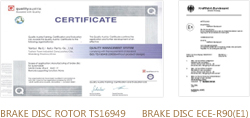1902 Arthur Raymond and Arthur Law form Royal Equipment Co.
1906 Woven brake linings are introduced by Royal.
1908 Asbestos brake linings are introduced.
1916 Royal Equipment becomes Raybestos.
1920 Hydraulic brakes are appearing on new cars, replacing mechanical brakes.
1923 The first dependable four-wheel brake system for the U.S. auto industry is introduced by Vincent Bendix and French inventor Henry Perrot.
1925 Captain Girling patented his wedge/roller actuated drum brake known as the “Girling Brake,” a concept still in use today.
1927 Brake systems now include vacuum brake boosters.
1928 Bendix Brake production reaches 3.6 million units.
1929 The “Girling Brake” patent was purchased by The New Hudson Company for supply to Ford, Austin, Rover and Riley.
1932 Ernest I. Schwarz (hence the acronym EIS), an immigrant from Vienna, refuses to accept the tight patent controls and exclusive aftermarket rights on hydraulic parts that exist through inventor Malcolm Lockheed and Hydraulic Brake Co. Schwarz starts to produce “aftermarket” brake components.
1951 Bendix introduces a power brake that evolves into the Master Vac vacuum-assist systems used on all cars.
1953 First Production of hydraulic disc brakes for Triumph.
1955 Wagner pioneers the use of high-temperature-resistant synthetic rubber compounds and high-boiling-point brake fluids.
1958 Cerametallic pads are introduced for high-performance applications.
1959 Self-adjusting brakes are used on passenger vehicles.
1960 Wagner develops and files a patent for the dual tandem master cylinder.
1962 Bendix introduces disc brakes to domestic cars. The Studebaker Avanti is the first to have them.
1966 Dual-cylinder brake systems are introduced by Wagner, based on a concept it had patented in 1926.
1968 Raybestos introduces tandem master cylinders.
World premier for floating frame calipers. Production of Annette calipers for Peugeot front and rear started.
1969 Front disc brakes are growing in popularity. Greater forces and higher pressures require proportioning valves to reduce hydraulic pressure to the rear drums.
Bendix introduces “anti-skid” (now known as ABS).
First production by Tokico of rear calipers with Lucas load-sensitive adjusters.
1974 The Girling Colette, the most successful fist type caliper design throughout the world went into production in Europe for Renault and Lancia and in Japan for Honda.
1975 Congress passes the Corporate Average Fuel Economy law forcing automakers to make lighter cars. Brake components start to get smaller.
1976 Load-sensing valves are introduced to control rear-braking forces.
Dynamic Brake Remanufacturing started in Montreal, Canada.
1977 Diagonal split systems provide front-wheel-drive cars with safe stopping if only one circuit is functioning.
1979 Semi-metallic disc pads are entering the market.
Low-drag calipers and quick-take-up master cylinders improve mileage by preventing the pad from dragging. The modified master cylinder provides extra fluid to re-apply (take up) the pads with minimum pedal travel.
1985 Traction control is appearing.
Dynamic Brake Remanufacturing, USA Division started.
1986 Anti-lock brake systems are available on the BMW and Corvette and some full-size GM and Ford vehicles.
First introduction of a low-cost ABS system in Ford Escort.
1987 Year of record 100 million Colette calipers produced worldwide.
1988 Asbestos-free pads are entering the marketplace. Kevlar formulas introduced to replace asbestos.
1994 ABS brakes becoming standard equipment on most cars. Most trucks have rear-wheel antilock brakes.
1999 Brakewarehouse.com formed as a Division of Dynamic Automotive Distributors, Inc.
2000 Ceramic-enhanced friction formulas become popular.
2002 ABS brakes become standard equipment on entry-level cars. Trucks have front and rear ABS now as standard equipment. 4-wheel disc braking systems are the rule instead of the exception.
2008 Web Distributors, Inc. acquires Brakewarehoues.com and starts development of AutoPartMonster.com — offering a comprehensive line of brand name automotive parts at competitive prices

